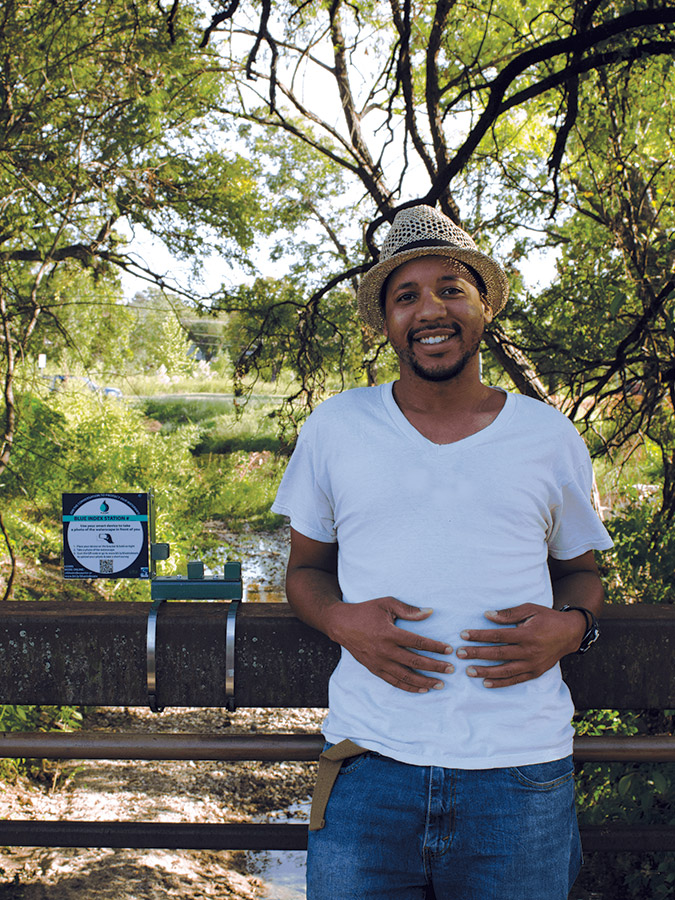To Witness Water
We are likely beyond the need to set up the story of water and human history. It is well established that civilizations, nomadic communities and colonizers have perpetually flocked to, fought for, and built identities and livelihoods around bodies of water. It’s elementary knowledge that most organisms cannot survive without regular access to the wet stuff, least of all under the blistering gaze of the sun in the sparsely shaded terrain of Texas.
But basic survival aside, it is well worth wading into what proximity to water means to humans on an emotional and spiritual level.
Even those with the privilege of a running tap and central air conditioning feel the pull throughout the ever-longer summer months to plunge into a spring-fed pool, paddle down a river, or at least splash their ankles in the shallows of an ephemeral creek for a spot of relief. Yet, beyond the saving grace of evaporative cooling (we do, after all, produce our own sweat for this purpose), can nearness to water affect our mental health? If we are led to a reflecting pool and lock eyes with an image of our own well-being, will we become the good stewards and conservationists our waterways need us to be? This stream of queries manifested as Blue Index, a research project initiated by then student/now landscape designer Kevin Jeffery.
Blue Index is a study designed to assess the effects waterscapes have on human wellness with the ultimate goals of increasing public participation, advancing urban design practices, and advocating for the requisite consideration of emotional welfare and community health in urban waterscape management. The public-facing piece of the Blue Index assessment involved 34 stations (erected throughout 17 watersheds) where visitors were prompted to take a photo of a water scene in front of them and fill out a digital survey. With 1,819 responses, the project met its goals of stimulating public participation in water management and highlighting the connection between mental health and closeness to waterscapes.
Two of the stations were posted at the Wildflower Center, one each at our Wetland Pond and Hill Country Stream. These watery vantage points, which are flanked by carefully tended native plant gardens, earned two of the highest relaxation and emotion scores. And the Hill Country Stream in our Woodland Garden — a peaceful, shaded retreat featuring interesting tree species such as Texas madrone (Arbutus xalapensis), American smoke tree (Cotinus obovatus) and Texas Hercules’ club (Zanthoxylum hirsutum), with an understory of dwarf palmettos (Sabal minor), red buckeyes (Aesculus pavia var. pavia) and seasonal wildflowers — received the highest Blue Index score overall, with guests noting “moving water” and “sound” as positive aspects. It stands to reason that since the health of waterscapes and landscapes are inextricably linked (and we depend wholly on both), humans would be drawn to spaces where their senses are swaddled in the many benefits of blue and green in balance.

Blue Index founder Kevin Jeffery at a station along Boggy Creek in Austin. He says the effort is currently transforming from research project to consulting service. PHOTO courtesy of Blue Index
Jeffery’s research for Blue Index Austin culminated in a 220-page report including all the prescribed scientific fixings (hypothesis, goals, methodology, findings, etc.), but takes a holistic approach by including historical, cultural and even artistic elements of interpretation. The project even has a creative director, Sarah Davidson. The study itself strays from the strictly impartial stance of traditional Western science and seeks to sway participants to not only inventory the benefits of water to their well-being, but to walk away from the experience with an empowered sense of stewardship. Blue Index cleverly leverages our individualism (“This makes me feel good, so it is important!”) to address a need for collective investment in the protection of shared waterways.
It is so inspiring that after all the literal crap we introduce to the water and nature, it still shows remarkable signs of resiliency and adaptation.
En route to positively impacting the future of water management, Jeffery ventures to challenge the common settler-colonial mindset of stewardship by presenting (and personally confronting) the historical significance and emotional impact of water on Black and Indigenous people. Chapter 1 of the report opens: “I would like to first acknowledge the traditional, ancestral, and unceded territory of the Tonakawa, Comanche, Lipan Apache, and Waco Indigenous peoples, on which Blue Index and countless others are learning, working, and organizing. On behalf of the project, we thank you for being the first stewards of these beautiful waterscapes, since time immemorial, and continuing to do so.” The report also acknowledges “the traumatic events that led to the removal of Indigenous peoples from this area.”
Jeffery says that his deep personal connection to water originated in childhood but also ties him to a collective past. He considers himself lucky to have learned to swim at his community pool, noting that, “A lot of Black people do not have this luxury or have negative associations with water. … Water, although a major source of freedom and respite for me, also represents trauma because of the history of slavery on the planet. Waterways were the slavers’ highways and ancestral graveyards for those who couldn’t or wouldn’t make the harsh journey.”

The Blue Index station at the Center’s Hill Country Stream received the top score overall, with particularly high marks for relaxation and emotion. PHOTO Wildflower Center
While acknowledging these heavier connections to the element, it’s also clear that he is an advocate for the rejuvenating and healing capacity of waterscapes. “It is so inspiring that after all the literal crap we introduce to the water and nature, it still shows remarkable signs of resiliency and adaptation,” says Jeffery.
While Blue Index’s field stations measured the surface effects of water on human emotions in a given moment, there is an undercurrent of hopefulness that the impacts will reverberate into the future. Texans will need hope — and much more — to stay afloat with climate change exacerbating both droughts and storms. And with a rapidly expanding human footprint increasing stormwater runoff and further straining potable water resources, it is crucial to have invested residents and equipped professionals advocating for the future of blue spaces and their biomes. If protecting endangered species and securing the survival of future generations haven’t quite gotten us there by now, maybe the concept of “selfcare” will be our bridge to truly embracing and conserving our vital, sacred waterways.

